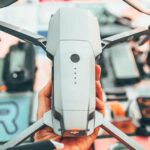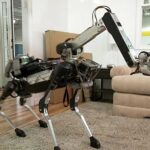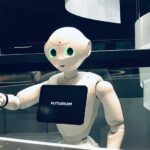ROBOT DOG
ROBOT DOG
AS TOUR GUIDE
Robotic dogs are machines designed to mimic the appearance and behavior of our canine companions but with a whole lot of technological prowess. Imagine a dog made of high-tech parts instead of fur! That’s a robot dog and they are very popular nowadays. Hence it is important to know about their capabilities and advancements being done to make them so useful.

ROBOT DOG AS A TOUR GUIDE



Here’s robot dog deployed at Vantara Aquaria Jamnagar, Gujarat which has the following capabilities to fulfill the expectations
- To guide the visitors coming to explore the Aquarium Gallery.
- Interact by conversation with visitors using AI based models.
- Can play music and dance to music for the entertainment of visitors.
- Activities like Running, Jumping, Backflip, shaking hands with the visitors, following humans and much more making visitor experience more delightful and memorable.
KEY FEATURES OF THE ROBOT DOG
High-Fidelity Perception
The robot boasts a proprietary 4D LiDAR sensor offering a near-hemispherical field of view with minimal blind spots. This enables highly accurate environmental mapping and obstacle detection crucial for real-world deployments. Additionally, the integrated Intel RealSense depth camera provides rich sensory data for complex tasks.

Agile Movement and Power

With a maximum speed of 3.5 meters per second, the robot is among the fastest robot dogs available. Its powerful motors, delivering up to 45 Nm of joint torque, ensure efficient navigation across diverse terrains, making it suitable for demanding environments.
Extended Operational Time
The robot comes standard with an 8,000mAh battery offering 2 hours of operation. An optional 15,000mAh battery extends runtime to 4 hours, allowing for prolonged deployments without frequent recharging.

AI-Driven Decision Making

The robot integrates a GPT language model, enabling real-time environmental analysis and informed decision making. This empowers the robot to adapt to dynamic situations and perform tasks autonomously.
Extended Operational Time
The robot offers both remote control and autonomous operation capabilities. Additionally, its ROS compatibility facilitates programming for customized behaviors and specialized applications.

Advanced Functionality Suite

The robot includes an intelligent side-follow system for effortless control, voice command functionality, and foot force sensors for enhanced stability and maneuverability.
WHY DO ROBOT DOGS ALIGN WITH OUR NEEDS?
Maneuverability
The robot’s agility allows it to navigate uneven terrain or crowded spaces, making it suitable for guiding people in diverse environments like hiking trails, museums, or historical sites.
Real-time obstacle detection
Equipped with LiDAR and depth sensors, the robot can avoid obstacles and ensure a safe path for your group.
Interactive features
The robot’s voice control capabilities could allow for hands-free interaction with the guide robot.
Entertainment value
The robot’s playful movements and design could add an engaging element to the guided tour
Simple, pre-programmed tours
The robot could be integrated into exhibits at museums or zoos, providing visitors with additional information or acting as a companion on their exploration.
Remote guiding
A human guide could remotely control the robot, allowing them to navigate challenging environments and deliver information to visitors virtually.
CASE STUDIES
Spot robot
Built by Boston Dynamics, Spot is a four-legged robot designed to be agile and mobile, able to navigate various terrains. Here are some of its key capabilities:
Data collection: Equipped with 360-degree perception sensors, Spot can gather data in environments that might be hazardous or difficult for humans to reach. This data can then be used to create digital twins of real-world spaces or for predictive maintenance purposes.

Unitree A1

The Unitree A1 is a high-performance quadruped robot, often called a robot dog, known for its athleticism, stability, and affordability.
Here’s a breakdown of its capabilities:
Speed and Agility:
The A1 can reach speeds of up to 3.3 meters per second (11.88 kilometers per hour), making it quite fast for a robot. It also boasts exceptional maneuverability and flexibility
MIT Cheetah robot
The MIT Cheetah is a high-performance quadrupedal robot designed by researchers at the Massachusetts Institute of Technology (MIT). It’s known for its impressive speed and agility, inspired by the cheetah, the fastest land animal.
High-Speed Running: The Cheetah can reach speeds of over 3.9 meters per second (almost 9 mph), making it one of the fastest-legged robots in existence.
Dynamic Maneuvers: They can perform complex maneuvers like jumping, turning at high speeds, and even recovering from being pushed or yanked.
Sensorless Navigation: Some versions of the Cheetah can navigate without relying on cameras or LiDAR sensors, using advanced algorithms for contact detection and control.

GALLERY




Contact Us
The latest Robot news and resources contact straight legal Point.
1168 Hamilton St #400, Vancouver, BC V6B 2S2
Telephone: +1-825-888-9393
bob@newagerobots.com, info@newagerobots.com
Useful Links
Copyright © techite all rights reserved.






